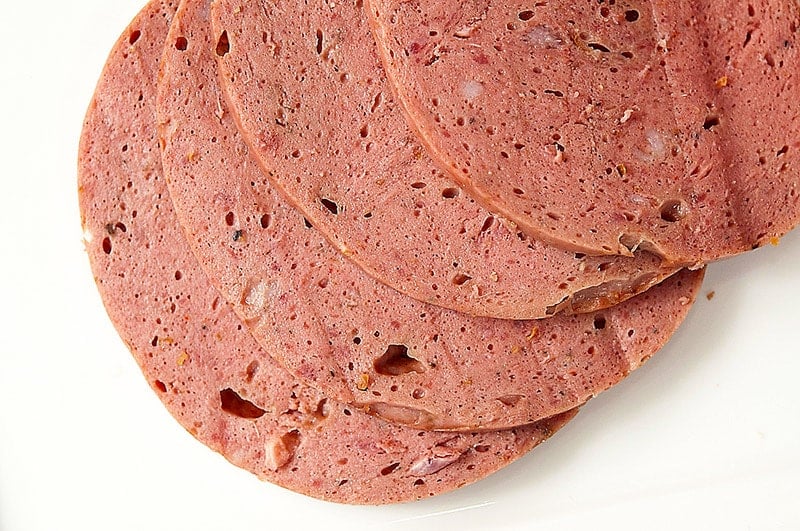
Mortadella is one of my favorite sandwich meats. It is what our baloney wishes it could be. It is an emulsified sausage, like a hot dog, but much tastier. Traditional versions are made from pork and often have pistachios in them. Some are stuffed in a casing, some are not.
This is my take on mortadella, based off a version I read in the now-defunct chef’s magazine Art Culinaire. It is duck mortadella, and it is done without a casing: You use plastic wrap to compress the meat mixture into a cylinder, then poach the meat gently in hot water.
I use a sous vide machine to poach my mortadella, but you could get away with a large stockpot filled with water — just watch your temperature like a hawk. You don’t want it hotter than about 165°F.
I make my mortadella with whatever duck or goose meat I have lying around. Snow geese and Canada geese are ideal for this recipe because they have lots of meat and can often have sketchy flavors in their skin and fat, making them excellent candidates for skinning. Hell, you could do this recipe with pork, wild boar, venison, whatever. But if you veer away from waterfowl, replace the duck fat with more pork fat.
Never made an emulsified sausage before? It’s not hard, but you need to have your wits about you, and you absolutely need to have everything ice cold. And I mean “ice cold.” Not 40°F, closer to and even a bit below 30°F. You need to whip ground meat and fat and ice together into an emulsion, but it really only works at low temperatures. If you have a good food processor, you’ll be fine.
If you don’t have a good food processor, cut this recipe in half or you will burn out the motor. If you don’t have a food processor at all, you are out of luck: You need one to get this emulsion.
How to eat mortadella? On a sandwich, of course. Or all by itself, with some pickles and maybe a dot of mustard. Mortadella also makes a great addition to stuffing, or a layer in a roulade.
New to making sausage? You can find my detailed tutorial on how to make sausages at home here.
Makes about 4 pounds
- 3 pounds duck or goose meat
- 8 ounces duck fat (rendered)
- 8 ounces pork fat
- 18 ounces ice
- 4 ounces dry milk powder
- 1 1/2 ounces kosher salt (40 grams)
- 2 teaspoons Instacure No. 1
- 2 teaspoons sugar
- 1 1/2 teaspoons nutmeg
- 1 teaspoon cayenne
- 2 teaspoons garlic powder
- 2 teaspoons black pepper
- 2 teaspoons ground coriander
- Lots of plastic wrap
- Cut the meat and pork fat into roughly 1-inch chunks and put in the freezer. Put the duck fat into the freezer. Let everything chill for about 45 minutes.
- Meanwhile, mix the salt and spices, but leave the dry milk separate.
- Mix the spices in with the goose meat and pork fat.
- Grind the meat and fat through the coarse die on your meat grinder. If you don’t have a meat grinder, you can pulse it into a paste with a food processor. Set in the fridge.
- Using a food processor, grind the ice into small pieces. Remove it and set in in a bowl in the freezer.
- Whip the meat in the food processor until it is a paste; if you used the processor to grind the meat in the first place, you can skip this step. Unless you have a large food processor, split the meat half.
- Split the ice in half and whip half the ice with half the meat until it is well incorporated. Repeat with the other half of the meat and ice.
- With the motor running on the food processor, start spooning in half the duck fat. Do this one spoonful at a time, and don’t add the next spoonful until the previous one is incorporated. Scoop the mixture out into a bowl and set in the fridge while you do the other half.
- Once the last of the duck fat has been incorporated into the second half of the meat, start spooning in half the dry milk powder. Again, do this one spoon at a time and let the dry milk get incorporated before adding the next one. At no point should the temperature go beyond 45°F. Halfway through the mixing process, use a thermometer to check.
- The finished mixture will look a little like coffee soft-serve ice cream. Scoop it into a bowl and set in the fridge while you finish the other half. Chill everything for 30 minutes or so while you clean up.
- To finish the mortadella, lay out two overlapping sheets of plastic wrap, each about 2 to 2 1/2 feet long. Make sure the long axis is facing you, as you are about to make a sort of burrito shape. Scoop some of the meat mixture onto the center of the plastic wrap and form into a log. Try to smooth out any potential air bubbles. Roll the plastic wrap around the log slowly, pushing air out and compressing the log into a nice cylinder.
- When it is wrapped, take one end of the plastic wrap and twist it away from you, over and over, until it compresses the sausage. Do the same with the other end of the plastic wrap, only this time twist it towards you. You want a tight cylinder. Tie the ends together, or tuck them underneath the sausage.
- Take another long piece of plastic wrap — long enough so you’ll be able to tie the ends together — and wrap the sausage again. This time you want to roll the sausage forward again and again to twist the ends. This motion makes an even better cylinder. Tie the ends together. Let the sausages chill in the fridge for an hour.
- Get a large pot of water steaming — you want it to be as close to 160°F as possible. I use a sous vide machine, which anchors the temperature where you want it, but you can get away with a large stockpot filled with water. Submerge the mortadella in the water; you might need to put a plate over them or something. Let them cook for 1 hour, but do not let the water get too hotter than 165°F or cooler than 155°F.
- When the sausages are cooked, plunge into a large bowl or bowls loaded with ice water. Keep them there for a good 30 minutes, replacing ice if it all melts away. Leave the sausages in the plastic wrap until you are ready to eat them. They should keep for 10 days in the fridge, and can be frozen. I would leave the mortadella in the plastic wrap, then vacuum seal another bag around it for freezing.
